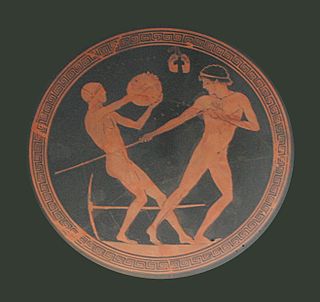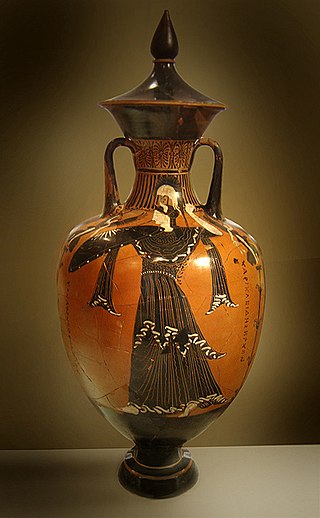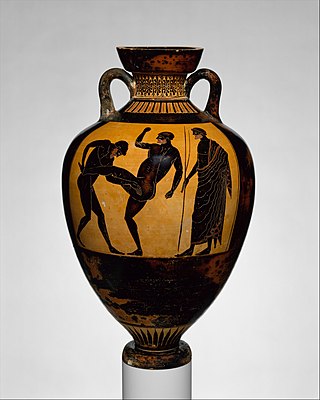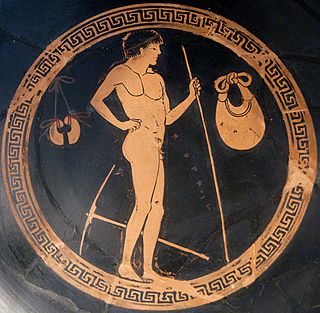
Pankration was an unarmed combat sport introduced into the Greek Olympic Games in 648 BC. The athletes used boxing and wrestling techniques but also others, such as kicking, holds, joint locks, and chokes on the ground, making it similar to modern mixed martial arts. The term comes from the Ancient Greek word παγκράτιον (pankrátion), meaning "all of power".

The Pythian Games were one of the four Panhellenic Games of Ancient Greece. They were held in honour of Apollo at his sanctuary in Delphi every four years, two years after the Olympic Games, and between each Nemean and Isthmian Games. The Pythian Games were founded sometime in the 6th century BC. In legend they were started by Apollo after he killed Python and set up the Oracle at Delphi. They continued until the 4th century AD.
Panhellenic Games is the collective term for four separate religious festivals held in ancient Greece that became especially well known for the athletic competitions they included. The four festivals were: the Olympic Games, which were held at Olympia in honor of Zeus; the Pythian Games, which took place in Delphi and honored Apollo; the Nemean Games, occurring at Nemea and also honoring Zeus; and, finally, the Isthmian Games set in Isthmia and held in honor of Poseidon. The places at which these games were held were considered to be "the four great panhellenic sanctuaries." Each of these Games took place over a four-year period, starting with the Olympics. Along with the fame and notoriety of winning the ancient Games, the athletes earned different crowns of leaves from the different Games. From the Olympics, the victor won an olive wreath, from the Pythian Games a laurel wreath, from the Nemean Games a crown of wild celery leaves, and from the Isthmian Games a crown of pine.

A pentathlon is a contest featuring five events. The name is derived from Greek: combining the words pente (five) and -athlon (competition). The first pentathlon was documented in Ancient Greece and was part of the Ancient Olympic Games. Five events were contested over one day for the Ancient Olympic pentathlon, starting with the long jump, javelin throwing, and discus throwing, followed by the stadion and wrestling. Pentathletes were considered to be among the most skilled athletes, and their training was often part of military service—each of the five events in the pentathlon was thought to be useful in war or battle.

Stadion or stade was an ancient running event and also the building in which it took place, as part of Panhellenic Games including the Ancient Olympic Games. The event was one of the five major Pentathlon events and the premier event of the gymnikos agon.

The Panathenaic Games were held every four years in Athens in Ancient Greece from 566 BC to the 3rd century AD. These Games incorporated religious festival, ceremony, athletic competitions, and cultural events hosted within a stadium.

The Panathenaea was a multi-day ancient Greek festival held annually in Athens that would always conclude on 28 Hekatombaion, the first month of the Attic calendar. The main purpose of the festival was for Athenians and non-Athenians to celebrate the goddess Athena. Every four years, the festival was celebrated in a larger manner over a longer time period with increased festivities and was known as the Great (or Greater) Panathenaea. In the years that the festival occurred that were not considered the Great Panathenaea, the festival was known as the Lesser Panathenaea. The festival consisted of various competitions and ceremonies, culminating with a religious procession that ended in the Acropolis of Athens.

A team sport is a type of sport where the fundamental nature of the game or sport requires the participation of multiple individuals working together as a team, and it is inherently impossible or highly impractical to execute the sport as a single-player endeavour. In team sports, the cooperative effort of team members is essential for the sport to function and achieve its objectives. The objective often involves teammates facilitating the movement of a ball or similar object in accordance with a set of rules in order to score points. Examples are basketball, volleyball, rugby, water polo, handball, lacrosse, cricket, baseball, and the various forms of football and hockey. These sports emphasize teamwork, strategy, and coordination among team members while competing against opposing teams to achieve a common goal. Team sports do not include individual or individual-to-team events within a sport.

Panathenaic amphorae were the amphorae, large ceramic vessels, that contained the olive oil given as a prize in the Panathenaic Games. Some were ten imperial gallons and 60–70 cm (24–28 in) high. This oil came from the sacred grove of Athena at Akademia. The amphorae which held it had the distinctive form of tight handles, narrow neck and feet, and they were decorated with consistent symbols, in a standard form using the black figure technique, and continued to be so, long after the black figure style had fallen out of fashion. Some Panathenaic amphorae depicted Athena Promachos, goddess of war, advancing between columns brandishing a spear and wearing the aegis, and next to her the inscription τῶν Ἀθήνηθεν ἄθλων "(one) of the prizes from Athens". On the back of the vase was a representation of the event for which it was an award. Sometimes roosters are depicted perched on top of the columns. The significance of the roosters remains a mystery. Later amphorae also had that year's archon's name written on it making finds of those vases archaeologically important.

Ancient Greek boxing dates back to at least the 8th century BC, and was practiced in a variety of social contexts in different Greek city-states. Most extant sources about ancient Greek boxing are fragmentary or legendary, making it difficult to reconstruct the rules, customs and history surrounding this activity in great detail. Still, it is clear that gloved boxing bouts were a significant part of ancient Greek athletic culture throughout the early classical period.

The ancient Olympic Games, or the ancient Olympics, were a series of athletic competitions among representatives of city-states and one of the Panhellenic Games of Ancient Greece. They were held at the Panhellenic religious sanctuary of Olympia, in honor of Zeus, and the Greeks gave them a mythological origin. The originating Olympic Games are traditionally dated to 776 BC. The games were held every four years, or Olympiad, which became a unit of time in historical chronologies. These Olympiads were referred to based on the winner of their stadion sprint, e.g., "the third year of the eighteenth Olympiad when Ladas of Argos won the stadion". They continued to be celebrated when Greece came under Roman rule in the 2nd century BC. Their last recorded celebration was in AD 393, under the emperor Theodosius I, but archaeological evidence indicates that some games were still held after this date. The games likely came to an end under Theodosius II, possibly in connection with a fire that burned down the temple of the Olympian Zeus during his reign.

The Ancient Olympic pentathlon was an athletic contest at the Ancient Olympic Games, and other Panhellenic Games of Ancient Greece. The name derives from Greek, combining the words pente (five) and athlon (competition). Five events were contested over one day, starting with the stadion, followed by the javelin throw, discus throw and long jump, and ending with wrestling. While pentathletes were considered to be inferior to the specialized athletes in a certain event, they were superior in overall development and were some of the most well balanced of all the athletes. Their training was often part of military service—each of the five events was thought to be useful in battle.

The Zappas Olympics, simply called Olympics at the time, were a series of athletic events held in Athens, Greece, in 1859, 1870 and 1875, sponsored by Greek businessman Evangelis Zappas. These games were one of the first revivals of the ancient Olympic Games in the modern era. Their success provided further inspiration for William Penny Brookes in England, whose games had been running since 1850, and the International Olympic Committee series from 1896.

In Ancient Greece, the history of running can be traced back to 776 BC. Running was important to members of ancient Greek society, and is consistently highlighted in documents referencing the Ancient Olympic Games. The stadion, for example, was so important that "[t]he Olympiad would be named after the victor, and since history itself was dated by the Games, it was he who thus gained the purest dose of immortality." The Olympic Games hosted a large variety of running events, each with its own set of rules. The ancient Greeks developed difficult training programs with specialized trainers in preparation for the Games. The training and competitive attitude of Greek athletes gives insight into how scientifically advanced Greece was for the time period.

The Apobates Base is a marble statue base featuring the scene of an Apobates competition or chariot race. The base, which is part of the collection at the Acropolis Museum in Athens, stands at 42 centimetres (17 in) in height and 86 centimetres (34 in) in width. A charioteer, armed athlete or warrior, and four horse-drawn chariot are depicted in profile relief. Named for the Greek “Apobatai” – literally the “Dismounters” – the base's relief depicts the racing event or Apobates race, which was a ceremonial part of the Panathenaic Games. In this event athletes would race against other athletes by dismounting and remounting moving chariots for prizes and renown.

The Euphiletos Painter Panathenaic Amphora is a black-figure terracotta amphora from the Archaic Period depicting a running race, now in the Metropolitan Museum of Art in New York. It was painted by the Euphiletos Painter as a victory prize for the Panathenaic Games in Athens in 530 BC.

The Kleophrades Panathenaic prize amphora is an Archaic period amphora by the Kleophrades Painter from the collection of the Metropolitan Museum of Art. Dating to c. 500 BCE, the amphora, filled with olive oil, was the prize for a victor in the Panathenaia games in Athens. This particular amphora is a neck amphora that stands at 63.5 centimetres (25.0 in) tall.

The kylix depicting pentathletes is an example of pottery and decoration from the late Archaic period. This piece is decorated both around the outside of the vessel and on the tondo inside with images of different events from the pentathlon. The drinking kylix is decorated in the red-figure style and is credited to the Proto-Panaitian group. It is currently at the Boston Museum for Fine Arts as part of their Ancient Greek collection.

This article presents a chronology of sporting development and events from time immemorial until the end of the 10th century CE. The major sporting event of the ancient Greek and Roman periods was the original Olympic Games, which were held every four years at Olympia for over a thousand years. Gladiatorial contests and chariot racing were massively popular. Some modern sports such as archery, athletics, boxing, football, horse racing and wrestling can directly trace their origins back to this period while later sports like cricket and golf trace their evolution from basic activities such as hitting a stone with a stick.
Kallipateira of Ialysos in Rhodes, was an Ancient Greek athlete trainer. She came from a renowned family of athletes in Ancient Greece. She was caught attending the ancient Olympic Games disguised as a male trainer in 388 BCE. Her capture led to a law being introduced that trainers should strip before entering the stadium.





















